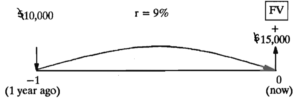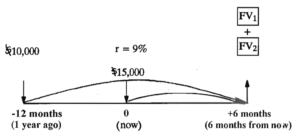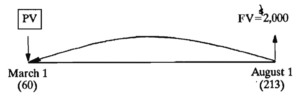3.8 Time Value of Money
The value of money involves accounting/or interest over time.
Introduction Using Future Value
The concept of VALUE of money involves accounting for interest over time.
Consider this question:
Would you rather have $5,000 now or $5,450 one year from now? Before you can answer this question, you must know what interest rate could be earned on the $5,000 if you made that choice. Assume 9% simple interest, and calculate the future value.

[latex]FV = P(1 + r t)[/latex]
[latex]=$5,000 (1 + 0.09 \times 1) =$5,450[/latex]
So, if you chose the $5,000 now and deposited it at 9%, in one year you would have $5,450, which “coincidentally” is the same as your other alternative. So there is no monetary difference between the two alternatives. The two VALUES are EQUIVALENT.
Key Takeaways
Remember that VALUE involves both interest rate and time. Try the following example Knowledge Check/
Knowledge Check 2.4
Would you rather have $10,000 now or $10,325 in 6 months time?
- the interest rate is 7%.
- the interest rate is 6%.
Equivalent Values
Key Takeaways
Now consider this problem:
Your company has borrowed $10,000 one year ago and $15,000 today. How much does the company owe? If you answered $25,000 you are making a common error. Dollars may NOT be compared (added or subtracted) when they are at different points in time. They may ONLY be compared by calculating EQUIVALENT values at the SAME POINT in time.
Example 3.8.1
Assume an interest rate of 9% and look at the problem again. (We are effectively saying that the $10,000 borrowed one year ago has a 9% simple interest obligation.) We can find the equivalent debt by calculating the equivalent value now of the $10,000 debt.

Now the two values may be added, since they are at the same point in time.
EQUIVALENT DEBT = $10,900 + $15,000 = $25,900
If both debts are settled TODAY, the company must pay $25,900.
How much must be paid to settle both debts SIX MONTHS from now?

If both debts are “moved” individually to the 1 year 6 month point they may be added.
[latex]FV_1=$10,000(1+0.09\times1.5)=$11,350[/latex]
[latex]FV_2=$15,000(1+0.09\times0.5)=$15,675[/latex]
[latex]Total \;Equivalent \;Debt=FV_1+FV_2=$11,350+$15,675=$27,025[/latex]
INTERPRETATION:
Each debt accumulates interest charges based on 9% per year, for the time the debt is outstanding.
Debt #1: $10,000 outstanding for 1½ years accumulates $1,350 interest charge and requires $11,350 repayment.
Debt #2: $15,000 outstanding for 6 months accumulates $675 interest charge and requires $15,675 repayment.
The total repayment is $27,025, which includes $2,025 total interest charges, at a point 6 months from now.
Knowledge Check 3.5
Debts of:
- $20,000 borrowed nine months ago, and
- $5,000 borrowed four months ago, and
- $10,000 borrowed today
must be repaid, together with simple interest at 8%, 6 months from now. How much must be paid to settle all the debts?
Present Value
In a similar manner to the “forward movement” along the time line, to obtain the future value, dollar amounts can be “moved backward” along the time line. The value of a FUTURE dollar amount at a point EARLIER in time is called the PRESENT VALUE. Usually this present value is calculated as the value now of an amount in the future, hence the name “Present” value. However, this is not a necessary condition. Any value, earlier in time than the dollar amount being considered is called “Present Value” at the point in time, and can be calculated in the same way.
Example 3.8.2
Find the value on March 1, 2021, of a repayment of $2,000 due on August 1, 2021.

Note: The day count number is in brackets.
To calculate the present value, a rate of interest, r, is required. The concept is that the present value can be considered as a deposit, at a given interest rate, which would amount to the $2,000 in the given time. For example, at an interest rate of 10%:
[latex]P=\frac{FV}{1+rt}=\frac{$2000}{\left(1+0.10\times \frac{153}{365}\right)}=$1,919.54[/latex]
Three interpretations of the answer are:
- $1,919.54 is the present value of $2,000, 153 days ahead in time if the interest rate is 10%.
- $1,919.54 now and $2,000 in 153 days have EQUIVALENT VALVES at 10%.
- To accumulate $2,000 in 153 days at 10%, a deposit of $1,919.54 is required.
The wording of the three interpretations is different but they really all say the same thing monetarily.
Knowledge Check 3.6
Try these examples:
-
- Find the value today of a promise to pay $5,000 1 year 7 months from now, if the simple interest rate is 9%.
- Find the total equivalent debt today of two future debts.
- $2,000 in 7 months, and
- $4,000 in 13 months.
Use a simple interest rate of 7% to value the debts.
Your Own Notes
- Are there any notes you want to take from this section? Is there anything you’d like to copy and paste below?
- These notes are for you only (they will not be stored anywhere)
- Make sure to download them at the end to use as a reference

